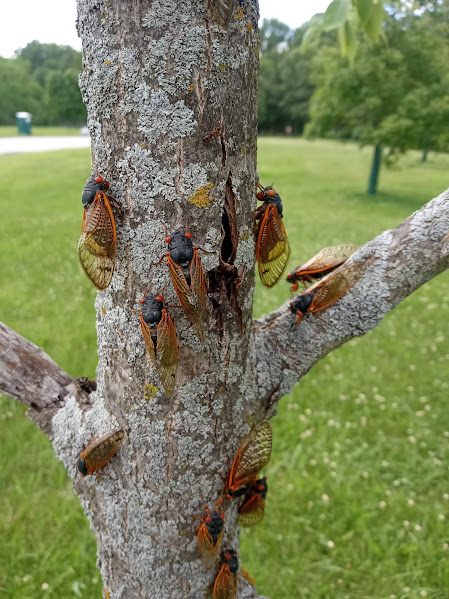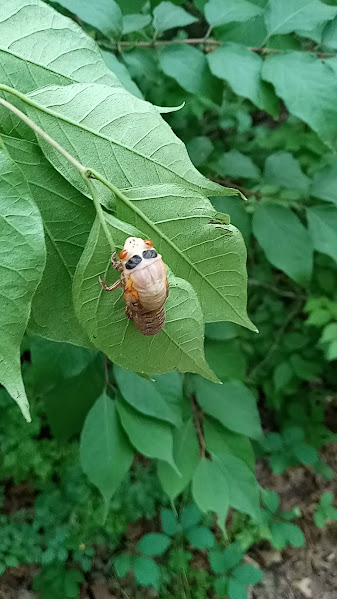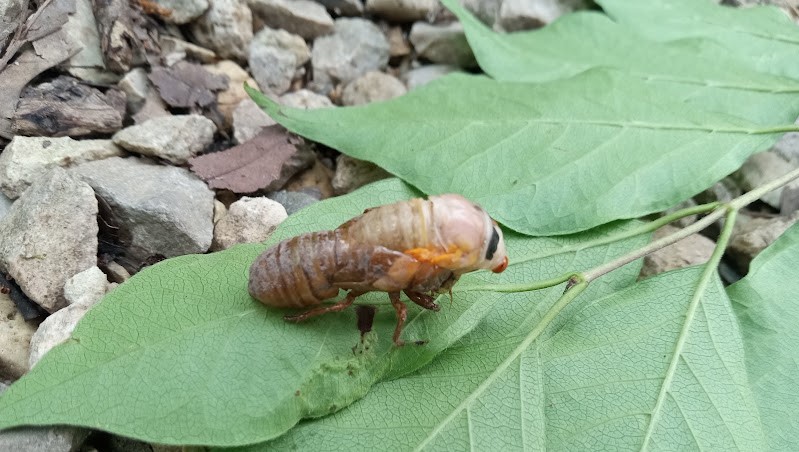Every summer, in forests and woodlands across the North American continent, cicada nymphs dig their way up from the underground tunnels where they spend the bulk of their lifecycle, to shed their skin one final time and emerge as adult insects. Adult cicadas live for only a short while, and during this brief stage their goal is to mate and lay eggs to secure a future for the next generation. However, while all cicadas spend the majority of their lives underground, in a select few species of these insects this part of the lifecycle lasts an unusually long time. Meet the periodical cicadas.

The term “periodical cicada” refers to any of several species in the genus Magiciada, whose adults emerge en masse every thirteen or seventeen years. The long period between emergences ensures the massive numbers of insects who claw their way to the Earth’s surface are able to overwhelm predators; no population of birds or insectivorous mammals can hope to consume more than a tiny fraction of the millions of cicadas who emerge simultaneously at the end of a thirteen or seventeen-year cycle.
Both thirteen and seventeen are prime numbers–and this, again, is an adaptation to ensure most of the adult cicadas won’t be eaten. Imagine if the insects had a fifteen-year life cycle; a predator that went through its own population boom-and-bust every five or three years could time its cycle so that a population boom regularly coincided with the emergence of huge numbers of cicadas. The fact that the cicada lifecycle is based on prime numbers ensures this doesn’t happen.

In most parts of the continent, cicadas emerge annually in relatively small numbers and camouflage themselves in treetops to avoid hungry birds. This means that, while you might occasionally hear them trilling from the forest canopy, you aren’t likely to see the insects. In contrast, periodical cicadas emerge literally by the millions, in such huge numbers that they can’t be missed. Their emergence is one of the greatest natural spectacles the insect world has to offer–and this month, I traveled to Illinois to see it for myself.
Different parts of US Midwest and South have their own cicada broods, each of which is on its own cycle–meaning a periodical cicada emergence is likely to be occurring somewhere in the country in any given year. However, 2024 was slated to be an especially big year, with two large broods emerging concurrently over an area that stretches from Georgia to southern Michigan, and overlapping in parts of Illinois. I planned to visit a tract of woods south of Chicago, in hopes of seeing the cicadas in their full glory–and I wasn’t disappointed.

After taking Amtrak from Washington State to Chicago, I made my way to the suburban community of Hickory Hills, which is adjacent to one of the largest undeveloped forests in the Chicago area: a collection of protected areas belonging to the network of Cook County Forest Preserves. I spent two days exploring this forest where the massive cicada emergence had recently commenced. Millions of the insects clung to the trunks and branches of trees and shrubs and the stems of grasses. Their sound was constant during the day, and louder than any insect cacophony I’ve heard outside of the tropics. There were cicadas everywhere you looked.
Cicadas are big insects–and because periodical cicadas aren’t really trying to hide from predators, they are brightly colored and easy to spot. The adult males spend the day singing, producing a shrill noise by vibrating membranes inside their abdomens in order to attract mates. Though a cicada emergence might call to mind a plague of locusts, the insects are completely harmless to people and do minimal damage to the plants whose juices they feed on. They aren’t considered a significant agricultural pest, nor do they have any ability to bite or sting. I got used to the occasional cicada alighting on my hat or shoulder, and relished the opportunity to see the insects up close.
The spectacular emergence of periodical cicadas in Illinois and other Midwestern states is a reminder that this part of the country still supports amazing biodiversity, and that you don’t have to go very far outside even a city as large as Chicago to find abundant nature. It’s also worth noting that because they spend so many years underground, feeding on the roots of trees, periodical cicadas are dependent on long-lived forests. Protecting the remaining intact forest ecosystems within their range should be a priority to ensure a future for Magacicada–and countless other unique animals and plants who thrive in this part of the continent.



Leave a comment